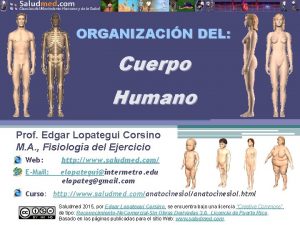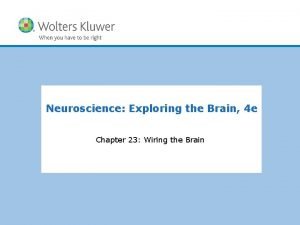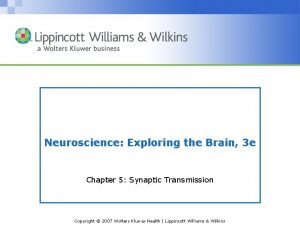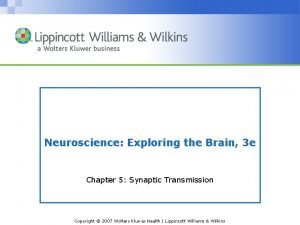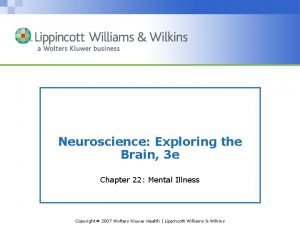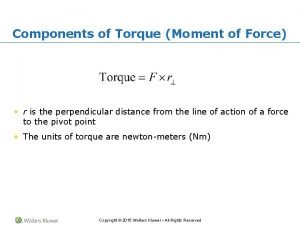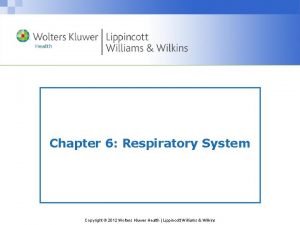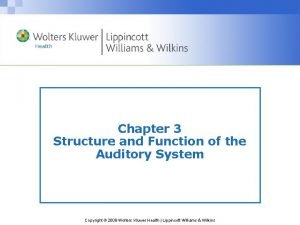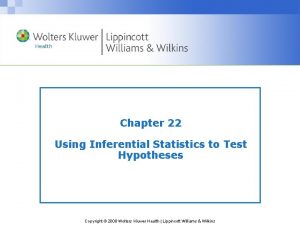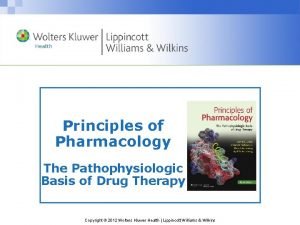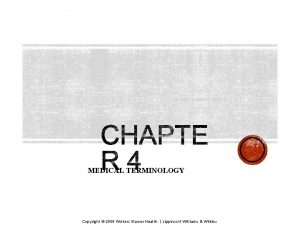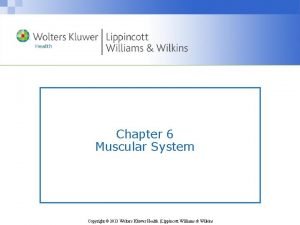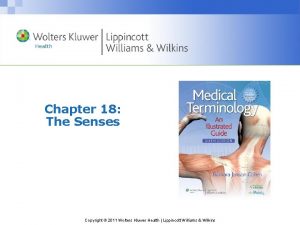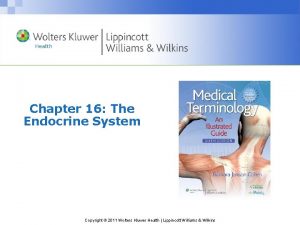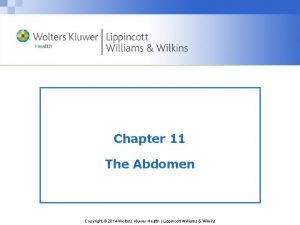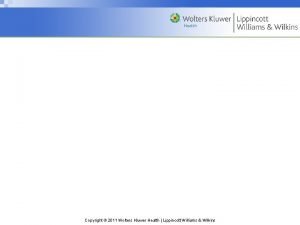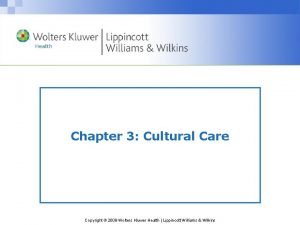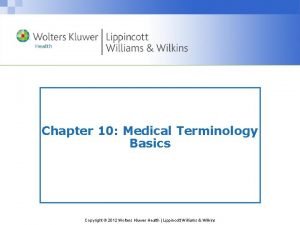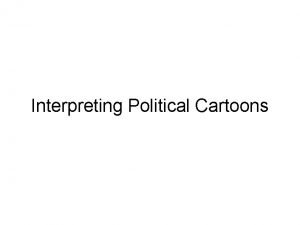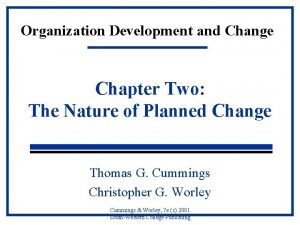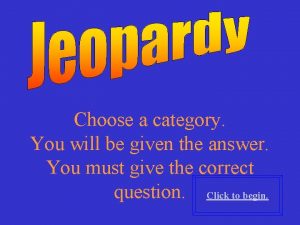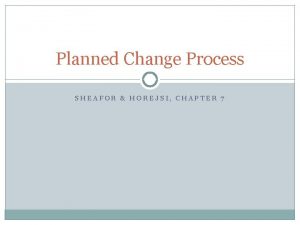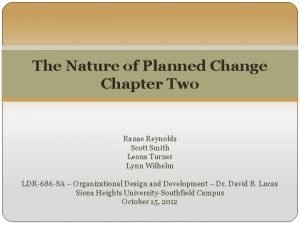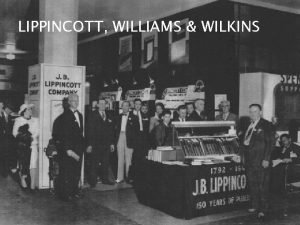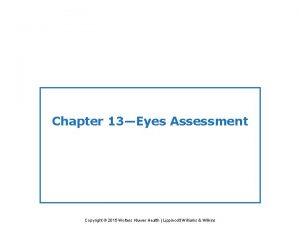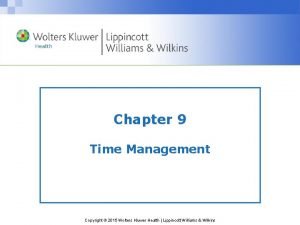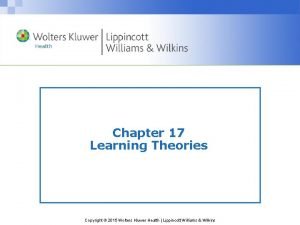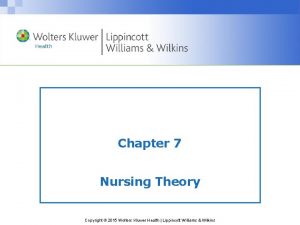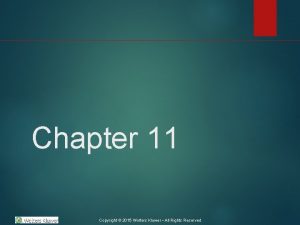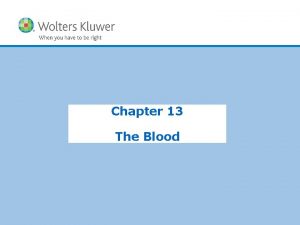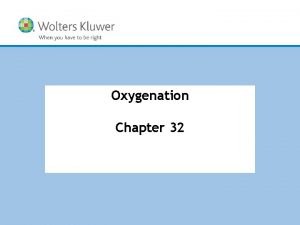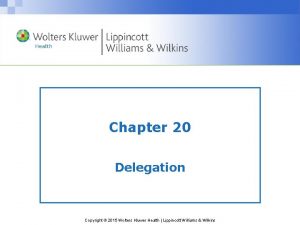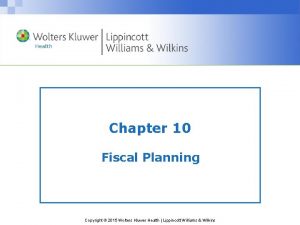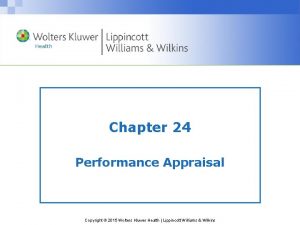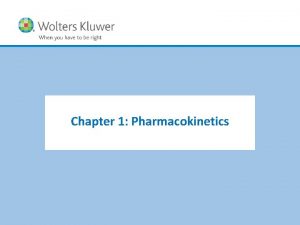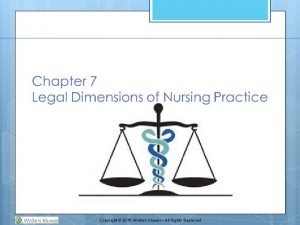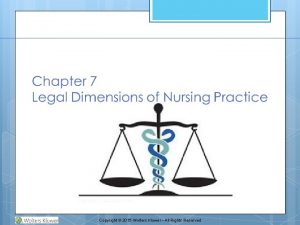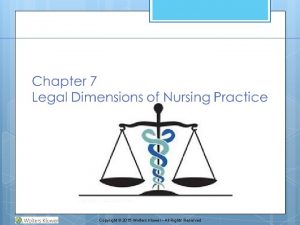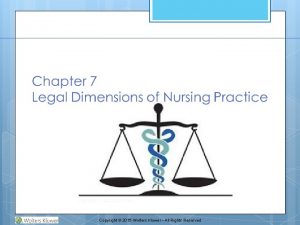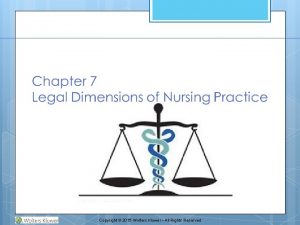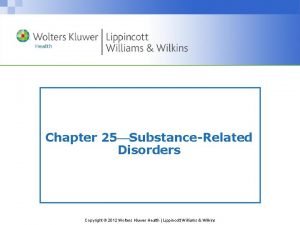Chapter 8 Planned Change Copyright 2015 Wolters Kluwer






























- Slides: 30

Chapter 8 Planned Change Copyright © 2015 Wolters Kluwer Health | Lippincott Williams & Wilkins

Direction of Change in Twenty-First Century Health-Care Organizations • Organizational restructuring • Quality improvement • Employee retention Copyright © 2015 Wolters Kluwer Health | Lippincott Williams & Wilkins

Qualities of Change Agents • Visionary • Risk taker • Flexible • Excellent communicator • Creative • Sensitive • Current Copyright © 2015 Wolters Kluwer Health | Lippincott Williams & Wilkins

Kurt Lewin’s Change Theory • Unfreezing: the change agent convinces members of the group to change or guilt, anxiety, or concern are elicited • Movement: the change agent identifies, plans, and implements appropriate strategies, ensuring that driving forces exceed restraining forces • Refreezing: the change agent assists in stabilizing the system change so that it becomes integrated into the status quo Copyright © 2015 Wolters Kluwer Health | Lippincott Williams & Wilkins

Lewin’s Driving and Restraining Forces • Driving (facilitators): forces that push the system toward change • Restraining (barriers): forces that pull the system away from change Copyright © 2015 Wolters Kluwer Health | Lippincott Williams & Wilkins

Driving and Restraining Forces (Goal: Return to School) Forces driving to reach the goal: • Opportunity for advancement • • Status, social gratification Enhanced self-esteem Family supportive of efforts Pay increase Forces restraining from reaching the goal: • Low energy level • Limited financial resources • Unreliable transportation • Time with family already limited Copyright © 2015 Wolters Kluwer Health | Lippincott Williams & Wilkins

Lewin (1951) Identified Several Rules That Should Be Followed in Implementing Change • Change should only be implemented for good reason • Change should always be gradual • All change should be planned, and not sporadic or sudden • All individuals who may be affected by the change should be involved in planning for the change Copyright © 2015 Wolters Kluwer Health | Lippincott Williams & Wilkins

Stages of Change Model (Burrowes and Needs, 2009) • Stage 1: Precontemplation • Stage 2: Contemplation • Stage 3: Preparation • Stage 4: Action • Stage 5: Maintenance • No current intention to change • Individual considers making a change • There is intent to make a change in the near future • Individual modifies his or her behavior • Change is maintained and relapse is avoided Copyright © 2015 Wolters Kluwer Health | Lippincott Williams & Wilkins

Classic Change Strategies • Rational–empirical strategies: used when there is little anticipated resistance to the change or when the change is perceived as reasonable • Normative–reeducative strategies: use group norms and peer pressure to socialize and influence people so that change will occur • Power-coercive strategies: feature the application of power by legitimate authority, economic sanctions, or political clout of the change agent Copyright © 2015 Wolters Kluwer Health | Lippincott Williams & Wilkins

Question A nurse-manager is attempting to restructure the unit to prevent understaffing of the nurses. The nurses agree this is a needed change. What type of change strategy would be most effective? A. Rational–empirical strategies B. Normative–reeducative strategies C. Power–coercive strategies D. None of the above Copyright © 2015 Wolters Kluwer Health | Lippincott Williams & Wilkins

Answer A. Rational–empirical strategies Rationale: When using rational–empirical strategies, the change agent assumes that resistance to change comes from a lack of knowledge and that humans are rational beings who will change when given factual information documenting the need for change. This type of strategy is used when there is little anticipated resistance to the change or when the change is perceived as reasonable Copyright © 2015 Wolters Kluwer Health | Lippincott Williams & Wilkins

Reminder • Because change disrupts the homeostasis or balance of the group, resistance should always be expected Copyright © 2015 Wolters Kluwer Health | Lippincott Williams & Wilkins

Complex Adaptive Systems Change Theory • Suggests that the relationship between elements and agents within any system is nonlinear and that these elements are the key players in changing settings or outcomes • Olson and Eoyang (2001) suggest that the self-organizing nature of human interactions in a complex organization leads to surprising effects Copyright © 2015 Wolters Kluwer Health | Lippincott Williams & Wilkins

Chaos Theory • Really about finding the underlying order in apparently random data • Determining this underlying order, however, is challenging, and the order itself is constantly changing • Changes in outcomes are not proportional to the degree of change in the initial condition Copyright © 2015 Wolters Kluwer Health | Lippincott Williams & Wilkins

Organizational Aging • Organizations progress through developmental stages • As organizations age, structure increases to provide greater control and coordination • The young organization is characterized by high energy, movement, and virtually constant change and adaptation • Aged organizations have established “turf boundaries, ” function in an orderly and predictable fashion, and are focused on rules and regulations Copyright © 2015 Wolters Kluwer Health | Lippincott Williams & Wilkins

Question Tell whether the following statement is true or false: The young organization is characterized by low energy and resistance to change. A. True B. False Copyright © 2015 Wolters Kluwer Health | Lippincott Williams & Wilkins

Answer B. False Rationale: The young organization is characterized by high energy, movement, and virtually constant change and adaptation Copyright © 2015 Wolters Kluwer Health | Lippincott Williams & Wilkins

Integrating Leadership and Management Functions in Planned Change • Manager: mechanic who implements the planned change • Leader: inventor or creator of the planned change Both leadership and management skills are necessary in planned change Copyright © 2015 Wolters Kluwer Health | Lippincott Williams & Wilkins

Planned Change versus Accidental Change • Regardless of the type of change, all major change brings feelings of achievement, pride, loss, and stress • Planned change, in contrast to accidental change or change by drift, is change that results from a wellthought-out and deliberate effort to make something happen Copyright © 2015 Wolters Kluwer Health | Lippincott Williams & Wilkins

Question Which emotions are commonly associated with change? A. B. C. D. E. Pride Stress Loss Achievement All of the above Copyright © 2015 Wolters Kluwer Health | Lippincott Williams & Wilkins

Answer E. All of the above Rationale: Change is associated with a wide range of feelings, some positive and others negative Copyright © 2015 Wolters Kluwer Health | Lippincott Williams & Wilkins

Three Good Reasons for Change • Change to solve some problem • Change to make work procedures more efficient • Change to reduce unnecessary workload Copyright © 2015 Wolters Kluwer Health | Lippincott Williams & Wilkins

Question Tell whether the following statement is True or False: For change to be effective, it should be immediate and sweeping. A. True B. False Copyright © 2015 Wolters Kluwer Health | Lippincott Williams & Wilkins

Answer B. False Rationale: Change should be gradual and carefully planned rather than sudden Copyright © 2015 Wolters Kluwer Health | Lippincott Williams & Wilkins

Attempting Change should never be attempted unless the change agent can make a commitment to be available until the change is complete Copyright © 2015 Wolters Kluwer Health | Lippincott Williams & Wilkins

Question Presenting employees with the pros and cons of a new system to be implemented is an example of which type of strategy? A. Rational B. Normative C. Power Copyright © 2015 Wolters Kluwer Health | Lippincott Williams & Wilkins

Answer A. Rationale: A rational change agent uses empirical reasoning as a tool for initiating change Copyright © 2015 Wolters Kluwer Health | Lippincott Williams & Wilkins

Resistance—The Natural and Expected Response to Change Individuals’ resistance typically depends on four things: • Their flexibility to change • Their evaluation of the immediate situation • The anticipated consequences of the change • Their perceptions of what they have to lose and gain Copyright © 2015 Wolters Kluwer Health | Lippincott Williams & Wilkins

Resistance to Change Perhaps the greatest factor contributing to the resistance encountered with change is a lack of trust between the employee and the manager or the employee and the organization Copyright © 2015 Wolters Kluwer Health | Lippincott Williams & Wilkins

Involvement in Change • Whenever possible, all those who may be affected by a change should be involved in planning for that change • When information and decision making are shared, subordinates feel that they have played a valuable role in the change Copyright © 2015 Wolters Kluwer Health | Lippincott Williams & Wilkins
 Wolters kluwer health
Wolters kluwer health Wolters kluwer health
Wolters kluwer health Wolters kluwer
Wolters kluwer Wolters kluwer
Wolters kluwer Synaptic integration
Synaptic integration Chemical synapse
Chemical synapse Wolters kluwer
Wolters kluwer Wolters kluwer
Wolters kluwer Wolters kluwer
Wolters kluwer Wolters kluwer
Wolters kluwer Wolters kluwer health
Wolters kluwer health Wolters kluwer
Wolters kluwer Wolters kluwer health
Wolters kluwer health Wolters kluwer health
Wolters kluwer health Virchows triad
Virchows triad Wolters kluwer pronunciation
Wolters kluwer pronunciation Wolters kluwer
Wolters kluwer Wolters kluwer
Wolters kluwer Wolters kluwer
Wolters kluwer Wolters kluwer
Wolters kluwer Physical examination techniques
Physical examination techniques Wolters kluwer ovid
Wolters kluwer ovid Wolters kluwer health lippincott williams & wilkins
Wolters kluwer health lippincott williams & wilkins Wolters kluwer culture
Wolters kluwer culture Wolters kluwer pronunciation
Wolters kluwer pronunciation Planned economy or planned destruction political cartoon
Planned economy or planned destruction political cartoon Critique of planned change
Critique of planned change Grandfolkie planned change theory
Grandfolkie planned change theory 7 step planned change process
7 step planned change process Nature of planned change
Nature of planned change Copyright 2015 all rights reserved
Copyright 2015 all rights reserved


